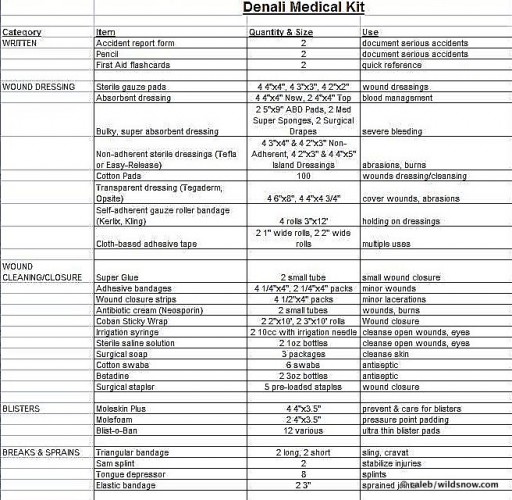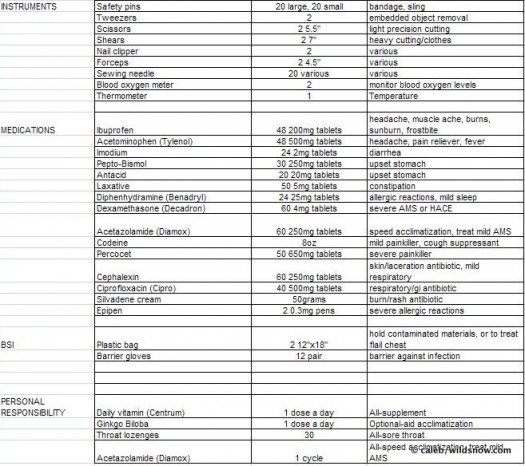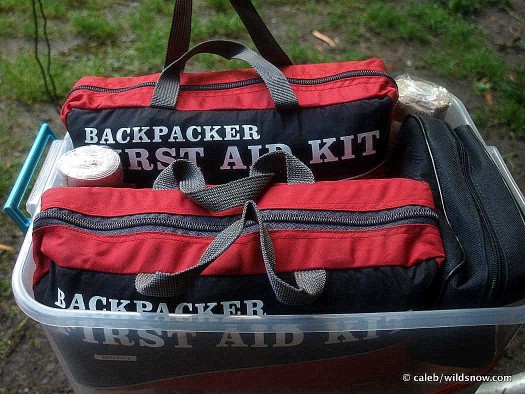Team responsibilities on big expeditions can usually be divided into five broad categories: cooking, camping, technical gear, repair, and medical. With each category the team needs both the right equipment and the expertise to use it properly. Fortunately, most of the Denali team members have some level of wilderness medical training.
As we divided up preparation responsibilities, I signed up for the task of assembling the expedition medical kit. The framework was simple; we wanted to be as self sufficient as possible, the larger kit had to be easily divided into two smaller kits, in case there is separation of our large group, and it needed to be as light, compact, and cost efficient as possible.
So with all those stipulations, I set about the task.
Step 1 was to create a master contents list.


I ran the first drafts of the list past a few backcountry ski buddies, who also happen to be doctors, and they helped me to refine to the above version. Blood management, infection prevention and treatment, and of course altitude related issues were the primary concerns. The only other notable decision was to use surgical staplers instead of sutures for serious laceration closure, mainly because they require less skill to apply safely and effectively.
Once the contents list was finalized, I moved on to step 2: gathering the contents. Building this kit from scratch allowed us to make things as light, functional, and customized as possible. However, it added significantly more work on the front end.
Needless to say, I was quite relieved when I got a call from Colby stating that he has friends at Dukal Medical Supply that would love to help us out. While I didn’t know the extent of Dukal’s product line, I did remember that I already had some of their products in my other first aid kits.
Colby passed along our contents list and told them we would be grateful for whatever they could provide. A few weeks later a giant box of medical supplies arrived on my doorstep. Once I inventoried the items, I realized we were already 75% fulfilled. So a huge THANK YOU! goes out to Dukal.
The remainder of the kit was completed with trips to the gear store, drug store, and a couple of big box chains.
Happily gazing at a spreadsheet full of black check marks, I moved on to the 3rd and final step: packaging. I looked at the many containment options I currently owned, no luck. Having reached mental dead end on the issue, I tried to recall previous expedition solutions. I finally remembered a custom kit my brother-in-law Jeremy put together for an expedition we took to the Yukon a few years ago. Seemed like it might work, so I called him up and he brought over the kit, or what was left of it.
After some examination, it appeared that the REI bag would work. But I needed two, and fortunately they had an identical bag for 50% off at the local store. Spending the $30 for the contents I wasn’t going to use felt wasteful, but at that stage I just wanted to get this thing wrapped up. While stripping the contents, I happened to notice a few Dukal products. It appears Dukal isn’t a stranger to the outdoor recreation community.

One of the two individual kits, packed and ready. Note: This is not an REI ad, this kit is far from anything REI's attorney's would ever approve.

I placed all medications in individual plastic pill baggies (available at any drug store), labeled with name, use, quantity, and dosage. I also labeled the concealed pouches of the kits with the contents (ex. blood management, wound closure, blister treatment)

After much repackaging and some organizational trial and error, I ended up with this. Two nearly identical kits packed into a Sterilite container for some impact and weather resistance.
As the saying goes, there are many ways to skin a cat. I think this holds true for creating expedition medical kit. Staples or sutures? Band-aids or super glue? Iodine or alcohol? In the end, I tried to strike a balance between practical variety and weight. The finished product weighs in at about 8lbs–a little over a pound a person–a fairly reasonable weight for a 3 week 7 person expedition.
WildSnow guest blogger Caleb Wray is a photographer and outdoor adventurer who lives in Colorado and travels worldwide. He enjoys everything from backcountry skiing to surfing.
